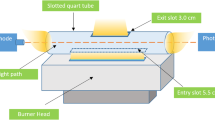Abstract
Chemical vapour generation has been used in combination with atomic fluorescence spectrometry to determine mercury at ultratrace concentrations down to 0.1 ng L−1. A time-based injection of 1 mL of solution for measurement was sufficient to generate a steady-state detector response in the direct mode of measurement. The detection limit calculated from a ten-point calibration curve according to DIN 32645 was 0.26 ng L−1. Instrument noise is limited by reflected radiation from the light source rather than by the dark current of the photomultiplier. The detection limit is directly influenced by the reagent blank which was 2 ng L−1 in the experiments described. Focusing by amalgamation and subsequent thermal desorption generates a detector response which is about eight times higher in peak intensity and about twice as large in integrated intensity. The detection limit under these conditions is 0.09 ng L−1 which can be further improved by preconcentration of larger volumes of solution for measurement. The cycle time for one individual reading is about 40 s without amalgamation and 125 s with amalgamation. The linear dynamic range of the system is five orders of magnitude with a single photomultiplier gain setting. The carry-over is less than 0.3% in direct measurement mode. Reference water samples and a surface water containing approximately 5 ng L−1 were used to prove the validity of the method for real samples. Good accuracy and recoveries of 103% were calculated using the fast direct determination technique.







Similar content being viewed by others
References
Hein H, Klaus S, Meyer A, Schwedt G (1999) Richt und Grenzwerte, 5th edn. Vogel, Würzburg, Germany
UNEP Chemicals (2003) Global Mercury Assessment Report, Geneva, Switzerland
Matsunaga K (1975) Nature 257:49
Lambertsson L, Lundberg E, Nilsson E, Frech W (2001) J Anal At Spectrom 16:1296–1301
Telliard WA (2001) United States Environmental Protection Agency, Federal Register, vol 67, no 209 EPA-821-R-01–033
Hatch WR, Ott WL (1968) Anal Chem 40:2085–2087
Welz B, Melcher M, Sinemus HW, Maier D (1984) At Spectrosc 5:37–42
Schroeder WH, Hamilton MC, Stobart SR (1985) Rev Anal Chem 8:179–209
McIntosh S (1993) At Spectrosc 14:47–49
McIntosh S, Baasner J, Grosser Z, Hanna C (1994) At Spectrosc 15:161–163
Winefordner JD, Vickers TJ (1964) Anal Chem 36:161
Winefordner JD, Elser RC (1971) Anal Chem 43:25A–40A
Cossa D, Sanjuan J, Cloud J, Stockwell PB, Corns WT (1995) J Anal At Spectrom 10:287–291
European Standard EN 13506 (2001) RefNrEN 13506:2001
Winefordner JD, Svoboda V, Cline LJ (1970) CRC Crit Rev Anal Chem 1:233
German Standard DIN 32645 (1994) Beuth, Berlin, Germany
International Organization for Standardization (1997) ISO/CD 13204/1
Author information
Authors and Affiliations
Corresponding author
Rights and permissions
About this article
Cite this article
Labatzke, T., Schlemmer, G. Ultratrace determination of mercury in water following EN and EPA standards using atomic fluorescence spectrometry. Anal Bioanal Chem 378, 1075–1082 (2004). https://doi.org/10.1007/s00216-003-2416-x
Received:
Revised:
Accepted:
Published:
Issue Date:
DOI: https://doi.org/10.1007/s00216-003-2416-x




